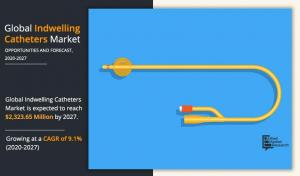Indwelling Catheters Market to Witness Substantial Growth of USD 2,323.56 million by 2027
PORTLAND, OREGON, UNITED STATES, April 28, 2023 /EINPresswire.com/ -- 𝐓𝐡𝐞 𝐢𝐧𝐝𝐰𝐞𝐥𝐥𝐢𝐧𝐠 𝐜𝐚𝐭𝐡𝐞𝐭𝐞𝐫𝐬 𝐦𝐚𝐫𝐤𝐞𝐭 𝐡𝐚𝐬 𝐛𝐞𝐞𝐧 𝐬𝐭𝐞𝐚𝐝𝐢𝐥𝐲 𝐠𝐫𝐨𝐰𝐢𝐧𝐠 𝐨𝐯𝐞𝐫 𝐭𝐡𝐞 𝐲𝐞𝐚𝐫𝐬, 𝐰𝐢𝐭𝐡 𝐚 𝐬𝐢𝐳𝐞 𝐨𝐟 $1,210.56 𝐦𝐢𝐥𝐥𝐢𝐨𝐧 𝐢𝐧 2019. 𝐓𝐡𝐢𝐬 𝐦𝐚𝐫𝐤𝐞𝐭 𝐢𝐬 𝐞𝐱𝐩𝐞𝐜𝐭𝐞𝐝 𝐭𝐨 𝐜𝐨𝐧𝐭𝐢𝐧𝐮𝐞 𝐭𝐨 𝐠𝐫𝐨𝐰 𝐚𝐭 𝐚 𝐂𝐀𝐆𝐑 𝐨𝐟 9.1% 𝐟𝐫𝐨𝐦 2020 𝐭𝐨 2027, 𝐫𝐞𝐚𝐜𝐡𝐢𝐧𝐠 𝐚 𝐬𝐢𝐳𝐞 𝐨𝐟 $2,323.56 𝐦𝐢𝐥𝐥𝐢𝐨𝐧 𝐛𝐲 𝐭𝐡𝐞 𝐞𝐧𝐝 𝐨𝐟 𝐭𝐡𝐞 𝐟𝐨𝐫𝐞𝐜𝐚𝐬𝐭 𝐩𝐞𝐫𝐢𝐨𝐝.
Indwelling catheters are medical devices that are inserted into the body to drain urine from the bladder. They are commonly used for patients who are unable to urinate on their own, such as those with spinal cord injuries or other neurological disorders. The increasing prevalence of such conditions, coupled with the growing elderly population, is driving the growth of the indwelling catheters market.
Moreover, the rise in hospital-acquired infections and the need for improved patient care have also contributed to the growth of this market. Indwelling catheters are often used in hospitals and other healthcare facilities, and the demand for these devices is expected to increase as healthcare providers focus on infection prevention and control measures.
𝐈𝐧𝐪𝐮𝐢𝐫𝐞 𝐁𝐞𝐟𝐨𝐫𝐞 𝐁𝐮𝐲𝐢𝐧𝐠: https://www.alliedmarketresearch.com/purchase-enquiry/7817
The key players operating in the global indwelling catheters market include 𝐀𝐦𝐬𝐢𝐧𝐨 𝐈𝐧𝐭𝐞𝐫𝐧𝐚𝐭𝐢𝐨𝐧𝐚𝐥, 𝐈𝐧𝐜, 𝐁𝐚𝐜𝐭𝐢𝐠𝐮𝐚𝐫𝐝, 𝐁. 𝐁𝐫𝐚𝐮𝐧 𝐌𝐞𝐥𝐬𝐮𝐧𝐠𝐞𝐧 𝐀𝐆, 𝐁𝐞𝐜𝐭𝐨𝐧, 𝐃𝐢𝐜𝐤𝐢𝐧𝐬𝐨𝐧 𝐚𝐧𝐝 𝐂𝐨𝐦𝐩𝐚𝐧𝐲, 𝐂𝐚𝐫𝐝𝐢𝐧𝐚𝐥 𝐇𝐞𝐚𝐥𝐭𝐡 𝐈𝐧𝐜., 𝐓𝐞𝐥𝐞𝐟𝐥𝐞𝐱 𝐈𝐧𝐜𝐨𝐫𝐩𝐨𝐫𝐚𝐭𝐞𝐝, 𝐂𝐨𝐥𝐨𝐩𝐥𝐚𝐬𝐭, 𝐌𝐞𝐝𝐥𝐢𝐧𝐞 𝐈𝐧𝐝𝐮𝐬𝐭𝐫𝐢𝐞𝐬, 𝐈𝐧𝐜., 𝐂𝐨𝐨𝐤 𝐌𝐞𝐝𝐢𝐜𝐚𝐥, 𝐈𝐧𝐜., 𝐒𝐮𝐧𝐦𝐞𝐝, 𝐋𝐥𝐜.
𝐈𝐧𝐝𝐰𝐞𝐥𝐥𝐢𝐧𝐠 𝐂𝐚𝐭𝐡𝐞𝐭𝐞𝐫𝐬 𝐌𝐚𝐫𝐤𝐞𝐭 𝐑𝐞𝐩𝐨𝐫𝐭 𝐇𝐢𝐠𝐡𝐥𝐢𝐠𝐡𝐭𝐬
𝐓𝐡𝐞 𝐢𝐧𝐝𝐰𝐞𝐥𝐥𝐢𝐧𝐠 𝐜𝐚𝐭𝐡𝐞𝐭𝐞𝐫𝐬 𝐦𝐚𝐫𝐤𝐞𝐭 𝐜𝐚𝐧 𝐛𝐞 𝐬𝐞𝐠𝐦𝐞𝐧𝐭𝐞𝐝 𝐛𝐲 𝐩𝐫𝐨𝐝𝐮𝐜𝐭, 𝐦𝐚𝐭𝐞𝐫𝐢𝐚𝐥, 𝐜𝐨𝐚𝐭𝐢𝐧𝐠 𝐭𝐲𝐩𝐞, 𝐚𝐩𝐩𝐥𝐢𝐜𝐚𝐭𝐢𝐨𝐧, 𝐚𝐧𝐝 𝐠𝐞𝐨𝐠𝐫𝐚𝐩𝐡𝐲.
Product Segmentation:
The market is divided into 2-way, 3-way, and 4-way catheters. 2-way catheters are the most commonly used type of indwelling catheters, whereas 3-way catheters are used when continuous irrigation is needed, and 4-way catheters are used when there is a need for both irrigation and aspiration.
Material Segmentation:
Indwelling catheters can be made from different materials such as latex, silicone, and PVC. Silicone catheters are considered to be the most biocompatible, and they are the most commonly used type of indwelling catheters.
Coating Type Segmentation:
Indwelling catheters can also be coated with different materials such as hydrogel, silver alloy, and silicone-elastomer. Hydrogel-coated catheters are designed to reduce friction and irritation during insertion, while silver alloy-coated catheters are designed to reduce the risk of infection. Silicone-elastomer-coated catheters are designed to reduce encrustation and blockage.
Application Segmentation:
Indwelling catheters are used in various applications such as post-surgical care, critical care, urinary incontinence, and benign prostate hyperplasia. Post-surgical care is the largest application segment, as indwelling catheters are often used in the post-operative period to allow for continuous urinary drainage.
𝐓𝐡𝐞 𝐢𝐧𝐝𝐰𝐞𝐥𝐥𝐢𝐧𝐠 𝐜𝐚𝐭𝐡𝐞𝐭𝐞𝐫𝐬 𝐦𝐚𝐫𝐤𝐞𝐭 𝐢𝐬 𝐬𝐞𝐠𝐦𝐞𝐧𝐭𝐞𝐝 𝐛𝐲 𝐫𝐞𝐠𝐢𝐨𝐧 𝐢𝐧𝐭𝐨 𝐍𝐨𝐫𝐭𝐡 𝐀𝐦𝐞𝐫𝐢𝐜𝐚, 𝐄𝐮𝐫𝐨𝐩𝐞, 𝐀𝐬𝐢𝐚-𝐏𝐚𝐜𝐢𝐟𝐢𝐜, 𝐚𝐧𝐝 𝐋𝐀𝐌𝐄𝐀 (𝐋𝐚𝐭𝐢𝐧 𝐀𝐦𝐞𝐫𝐢𝐜𝐚, 𝐌𝐢𝐝𝐝𝐥𝐞 𝐄𝐚𝐬𝐭, 𝐚𝐧𝐝 𝐀𝐟𝐫𝐢𝐜𝐚).
North America:
The North American market for indwelling catheters is the largest, accounting for a significant share of the global market. The United States, Canada, and Mexico are the major markets in this region. The high prevalence of urological disorders, growing geriatric population, and advanced healthcare infrastructure are some of the factors driving the growth of this market in North America.
Europe:
Europe is the second-largest market for indwelling catheters, with Germany, France, the United Kingdom, Italy, Spain, and the rest of Europe being the major markets. The increasing demand for advanced medical devices and the growing incidence of urinary disorders are the key factors driving the growth of this market in Europe.
Asia-Pacific:
The Asia-Pacific region is expected to witness significant growth in the indwelling catheters market during the forecast period. Japan, China, India, Australia, and the rest of Asia-Pacific are the major markets in this region. The increasing prevalence of urological disorders, rising healthcare expenditure, and increasing awareness about advanced medical devices are some of the factors driving the growth of this market in the Asia-Pacific region.
LAMEA:
The LAMEA region is expected to witness moderate growth in the indwelling catheters market during the forecast period. Brazil, South Africa, Saudi Arabia, and the rest of LAMEA are the major markets in this region. The increasing adoption of advanced medical devices and the growing awareness about healthcare facilities are some of the factors driving the growth of this market in the LAMEA region.
𝐅𝐑𝐄𝐐𝐔𝐄𝐍𝐓𝐋𝐘 𝐀𝐒𝐊𝐄𝐃 𝐐𝐔𝐄𝐒𝐓𝐈𝐎𝐍𝐒?
1. What are some of the key drivers for the growth of the indwelling catheters market?
2. How does the market for 2-way catheters compare to that of 3-way and 4-way catheters?
3. What are the advantages of using silicone catheters over other materials in the indwelling catheters market?
4. What are some of the most common applications of indwelling catheters?
5. What factors are contributing to the growth of the indwelling catheters market in the Asia-Pacific region?
6. What are some of the challenges facing manufacturers in the indwelling catheters market?
7. How are advancements in technology impacting the indwelling catheters market?
8. What is the impact of the COVID-19 pandemic on the indwelling catheters market?
9. How do regulations and reimbursement policies impact the indwelling catheters market?
10. What are some of the latest trends and innovations in the indwelling catheters market?
𝐏𝐔𝐑𝐂𝐇𝐀𝐒𝐄 𝐅𝐔𝐋𝐋 𝐑𝐄𝐏𝐎𝐑𝐓: https://www.alliedmarketresearch.com/indwelling-catheters-market/purchase-options
David Correa
Allied Analytics LLP
+1-800-792-5285
email us here
Legal Disclaimer:
EIN Presswire provides this news content "as is" without warranty of any kind. We do not accept any responsibility or liability for the accuracy, content, images, videos, licenses, completeness, legality, or reliability of the information contained in this article. If you have any complaints or copyright issues related to this article, kindly contact the author above.

